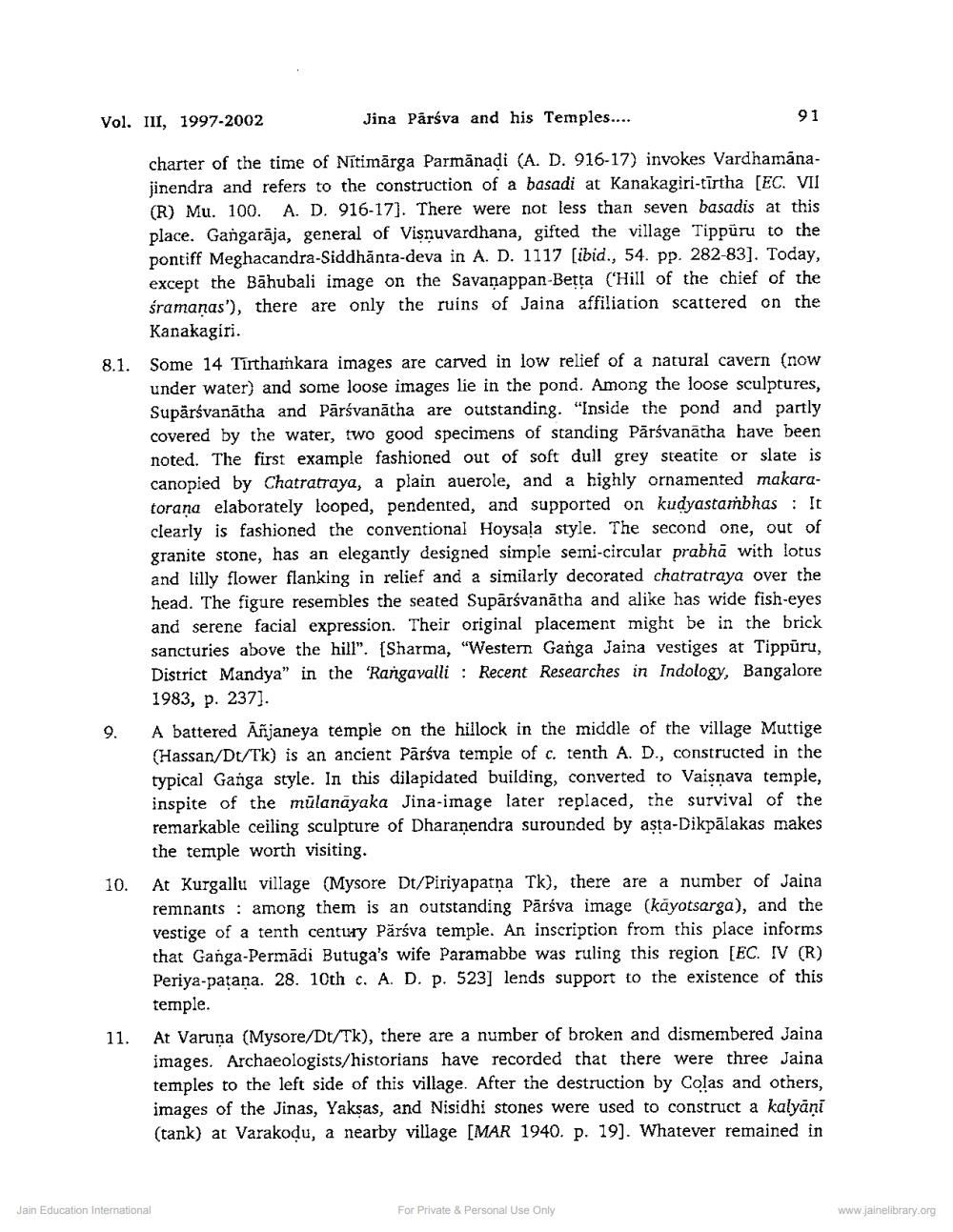Book Title: Jin Parsva and His Temples in Inscriptions of Karnataka Author(s): Hampa Nagrajaiha Publisher: Z_Nirgrantha_1_022701.pdf and Nirgrantha_2_022702.pdf and Nirgrantha_3_022703.pdf View full book textPage 8
________________ Vol. III, 1997-2002 Jina Pärśva and his Temples.... 91 8.1. charter of the time of Nītimārga Parmānadi (A. D. 916-17) invokes Vardhamanajinendra and refers to the construction of a basadi at Kanakagiri-tīrtha (EC. VII (R) Mu. 100. A. D. 916-17). There were not less than seven basadis at this place. Gangarāja, general of Visnuvardhana, gifted the village Tippuru to the pontiff Meghacandra-Siddhānta-deva in A. D. 1117 (ibid., 54. pp. 282-83]. Today, except the Bahubali image on the Savanappan-Betta ('Hill of the chief of the śramanas'), there are only the ruins of Jaina affiliation scattered on the Kanakagiri. Some 14 Tirthamkara images are carved in low relief of a natural cavern (now under water) and some loose images lie in the pond. Among the loose sculptures, Supärśvanātha and Pārsvanātha are outstanding. "Inside the pond and partly covered by the water, two good specimens of standing Pārsvanātha have been noted. The first example fashioned out of soft dull grey steatite or slate is canopied by Chatratraya, a plain auerole, and a highly ornamented makaratorana elaborately looped, pendented, and supported on kudyastambhas : It clearly is fashioned the conventional Hoysala style. The second one, out of granite stone, has an elegantly designed simple semi-circular prabhā with lotus and lilly flower flanking in relief and a similarly decorated chatratraya over the head. The figure resembles the seated Supārsvanātha and alike has wide fish-eyes and serene facial expression. Their original placement might be in the brick sancturies above the hill". (Sharma, "Western Ganga Jaina vestiges at Tippūru, District Mandya” in the Rangavalli : Recent Researches in Indology, Bangalore 1983, p. 237). A battered Āñjaneya temple on the hillock in the middle of the village Muttige (Hassan/Dt/Tk) is an ancient Pārsva temple of c. tenth A. D., constructed in the typical Ganga style. In this dilapidated building, converted to Vaisnava temple, inspite of the mūlanayaka Jina-image later replaced, the survival of the remarkable ceiling sculpture of Dharanendra surounded by asta-Dikpālakas makes the temple worth visiting. At Kurgallu village (Mysore Dt/Piriyapatņa Tk), there are a number of Jaina remnants : among them is an outstanding Pārsva image (kayotsarga), and the vestige of a tenth century Päráva temple. An inscription from this place informs that Ganga-Permādi Butuga's wife Paramabbe was ruling this region [EC. IV (R) Periya-patana. 28. 10th c. A. D. p. 523] lends support to the existence of this temple. At Varuna (Mysore/Dt/Tk), there are a number of broken and dismembered Jaina images. Archaeologists/historians have recorded that there were three Jaina temples to the left side of this village. After the destruction by Colas and others, images of the Jinas, Yaksas, and Nisidhi stones were used to construct a kalyāņi (tank) at Varakodu, a nearby village (MAR 1940. p. 19). Whatever remained in 10. 11. Jain Education International For Private & Personal Use Only www.jainelibrary.orgPage Navigation
1 ... 6 7 8 9 10 11 12 13 14 15 16 17 18 19 20 21 22 23
